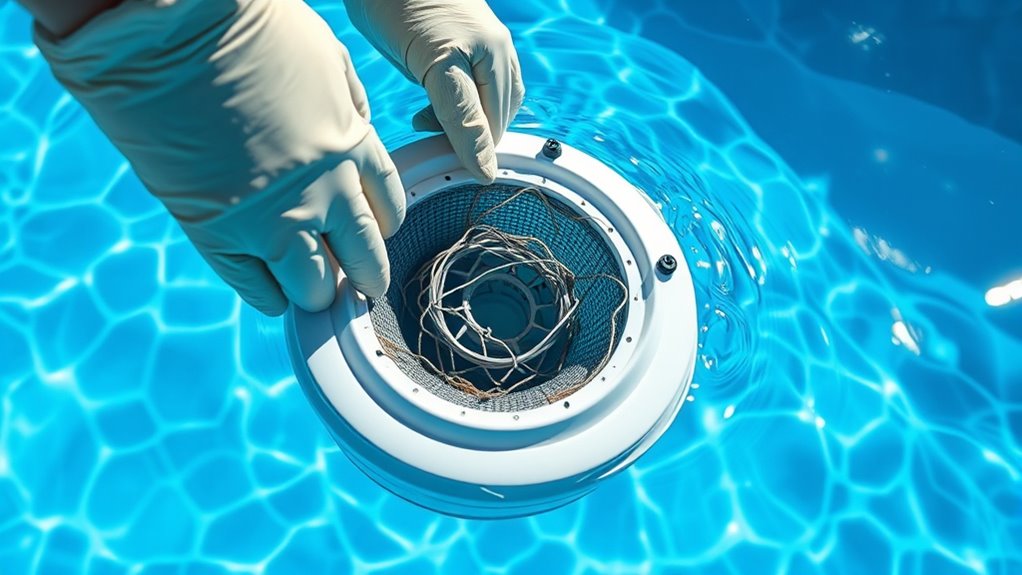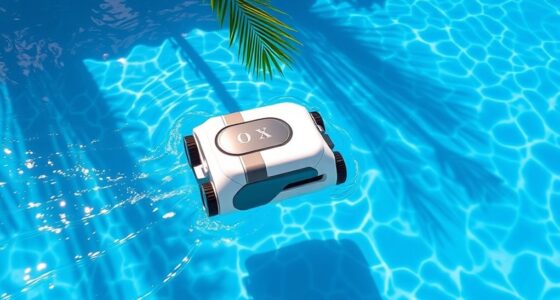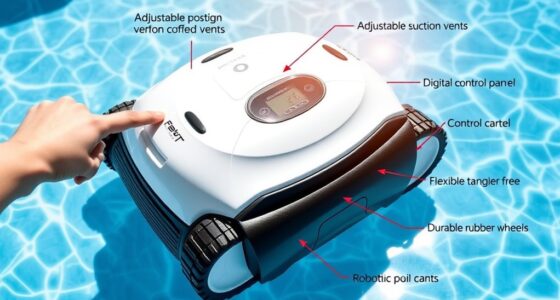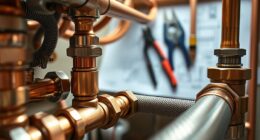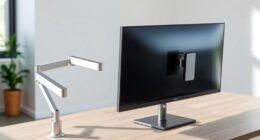If your suction pool cleaner isn’t working well, start by checking the power source and resetting any tripped circuit breakers or replacing blown fuses. Examine hoses and nozzles for obstructions or debris, and make certain everything’s properly attached and aligned. Clear debris from the skimmer and pump baskets, and confirm the water flow and pressure are within normal ranges. Replacing damaged seals or parts can help restore function. Keep up with regular maintenance to prevent future issues. More tips to troubleshoot await you.
Key Takeaways
- Check electrical connections, circuit breakers, and power cords for damage or tripping issues.
- Inspect hoses and nozzles for obstructions, kinks, or debris buildup, and clear blockages.
- Ensure the cleaner’s seals, wheels, and brushes are properly aligned and free of wear or damage.
- Monitor water flow and pressure; adjust valves or pump settings to optimize suction and cleaning efficiency.
- Clean filter baskets regularly and store the cleaner in a dry, shaded area to prevent obstructions and damage.
Checking the Power Source and Fuses
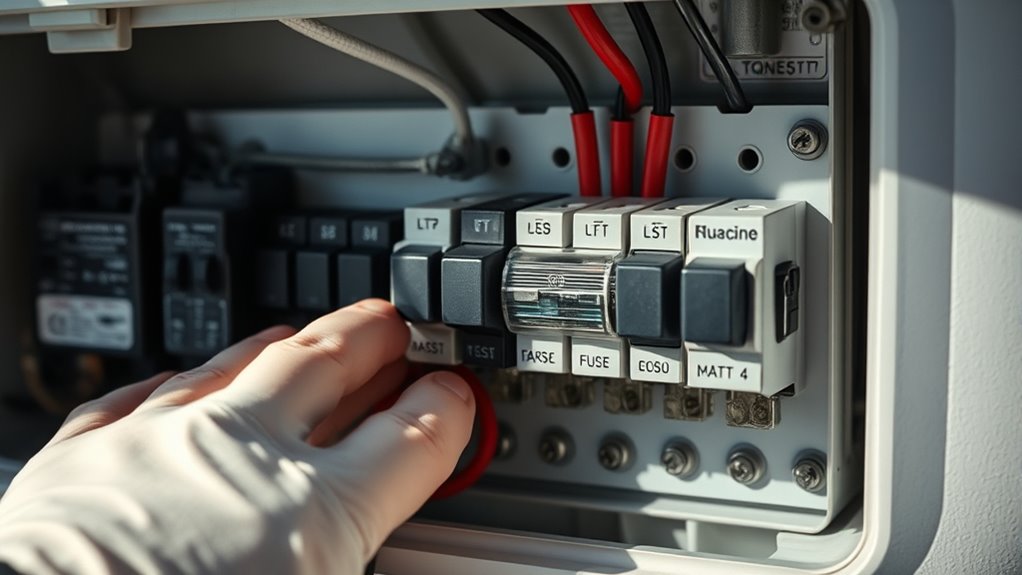
Before troubleshooting your suction pool cleaner, make sure it’s properly connected to the power source. Check the electrical wiring to ensure all connections are secure and undamaged. If your cleaner isn’t turning on, inspect the circuit breakers in your main panel. Sometimes, a circuit breaker trips, cutting off power to the outlet. Reset any tripped breakers and see if the cleaner powers up. Avoid ignoring blown fuses; if your system has fuses, replace any that are blown. Confirm the outlet itself is working by plugging in another device. Also, verify the power cord isn’t frayed or damaged. Proper electrical connections and functioning circuit breakers are essential for your pool cleaner to operate smoothly. Additionally, ensure that any power source upgrades or maintenance are up to date for optimal performance. Regularly checking your electrical components can prevent unexpected malfunctions and extend the lifespan of your equipment. Staying informed about electrical safety practices helps ensure safe operation and maintenance.
Inspecting and Clearing Clogs in the Hose and Nozzle
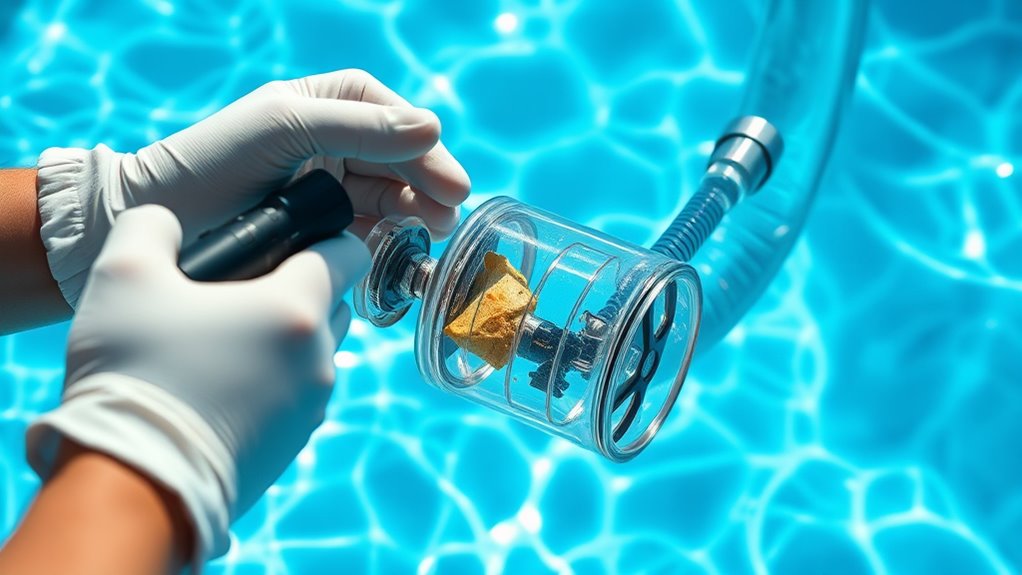
Start by checking the hose for blockages that might be restricting water flow. Remove any obstructions from the nozzle to restore proper suction. Using effective cleaning techniques guarantees your cleaner operates smoothly and efficiently.
Hose Blockages Identified
Hose blockages are a common cause of suction issues in pool cleaners, so it’s important to inspect both the hose and nozzle thoroughly. Look for any signs of hose blockages, which often stem from debris accumulation inside the hose. Remove the hose from the cleaner and check for any visible obstructions or kinks that could restrict water flow. Feel along the length of the hose for areas where debris might be lodged, especially near the connectors or bends. Clear out any debris or buildup using a hose brush or by flushing it with water. Ensure the hose is free of obstructions before reconnecting it. Regularly inspecting and maintaining your equipment can prevent performance decline and ensure optimal operation. Additionally, regularly monitoring for AI vulnerabilities in equipment or systems can help prevent unexpected malfunctions. Incorporating preventive maintenance routines can further extend the lifespan of your pool cleaning system. To improve overall efficiency, consider checking the filter system regularly for clogs or dirt buildup. Addressing hose blockages promptly can restore proper suction and keep your pool cleaner functioning efficiently. Performing routine inspections can also help identify early signs of wear that may lead to equipment failure if left unaddressed.
Nozzle Obstructions Removed
If your pool cleaner still isn’t suctioning properly, it’s important to examine the nozzle for obstructions. Clogs can block water flow, reducing suction and cleaning efficiency. First, inspect the nozzle for debris or buildup that might cause suction cup issues. Second, clear any obstructions carefully to restore proper water flow. Third, ensure the nozzle is properly aligned; misalignment can diminish suction and cause the cleaner to malfunction. Sometimes, debris or mineral deposits can block the nozzle, so you might need to remove and rinse it thoroughly. Also, check that the nozzle’s position allows for a tight seal, preventing air leaks that could disrupt suction. Regular maintenance and understanding how to track your pool cleaner’s performance can help identify issues early and keep your cleaner functioning optimally. Additionally, using a HEPA filter can improve overall filtration and reduce debris buildup in your pool system. Properly inspecting and maintaining the nozzle can prevent repeated clogs and improve overall efficiency of the pool cleaner. Incorporating knowledge about water flow dynamics can also help optimize your cleaning routine. Taking these steps helps ensure the nozzle functions correctly, improving your pool cleaner’s performance.
Effective Cleaning Techniques
To guarantee your pool cleaner works efficiently, regularly inspect and clear clogs in the hose and nozzle. Blockages can reduce suction power, making it harder to clean effectively. Before cleaning, check your pool’s chlorine levels and ensure the pool chemical balance is correct, as imbalanced water can lead to debris buildup. Remove any debris or obstructions from the hose and nozzle, paying close attention to areas where debris tends to accumulate. Use a hose brush or a flexible tool to clear narrow passages. After clearing, run the cleaner to verify proper suction. Maintaining balanced chlorine levels and proper pool chemistry helps prevent debris from sticking and clogging your cleaner, guaranteeing optimal performance during each cleaning cycle. Additionally, inspecting for filter clogs and replacing filters as needed can further ensure your cleaner maintains strong suction and efficient operation.
Ensuring Proper Attachment and Alignment of the Cleaner
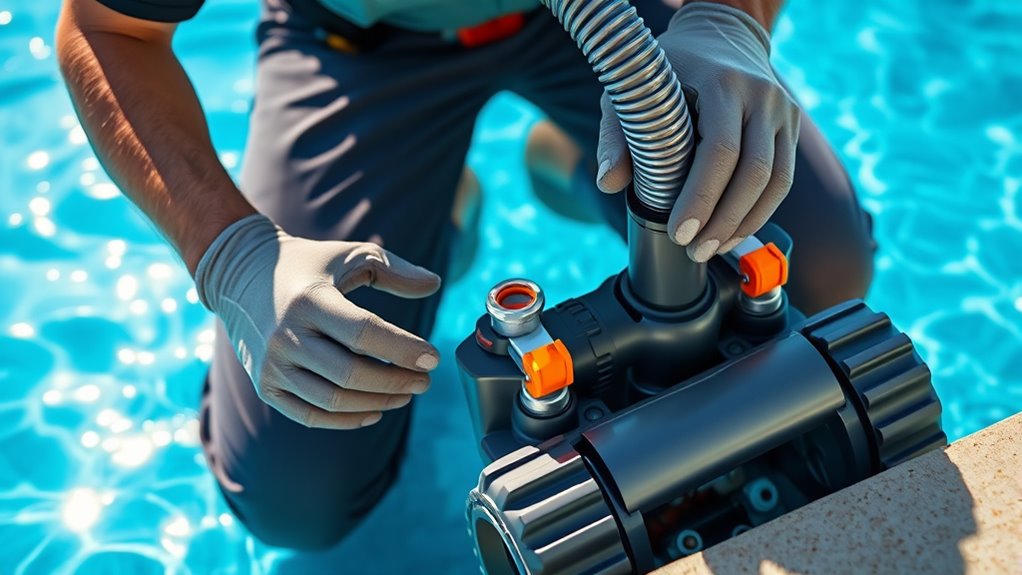
Ensuring proper attachment and alignment of your suction pool cleaner is essential for its peak performance. If the cleaner isn’t correctly attached, it may not move efficiently or pick up debris properly, leading to alignment issues. To avoid this, check these key points:
- Verify the cleaner’s hose connection is secure and snug to prevent leaks or detachment.
- Make sure the cleaner’s body is aligned with the hose and pool surface, avoiding twists or kinks.
- Confirm the wheels or brushes are properly positioned and not obstructed, ensuring smooth movement.
Proper attachment and correct alignment prevent common issues like poor suction or uneven cleaning, helping your cleaner operate at its best and extend its lifespan. Regularly inspecting these aspects keeps your pool spotless.
Examining the Skimmer and Pump Basket for Obstructions
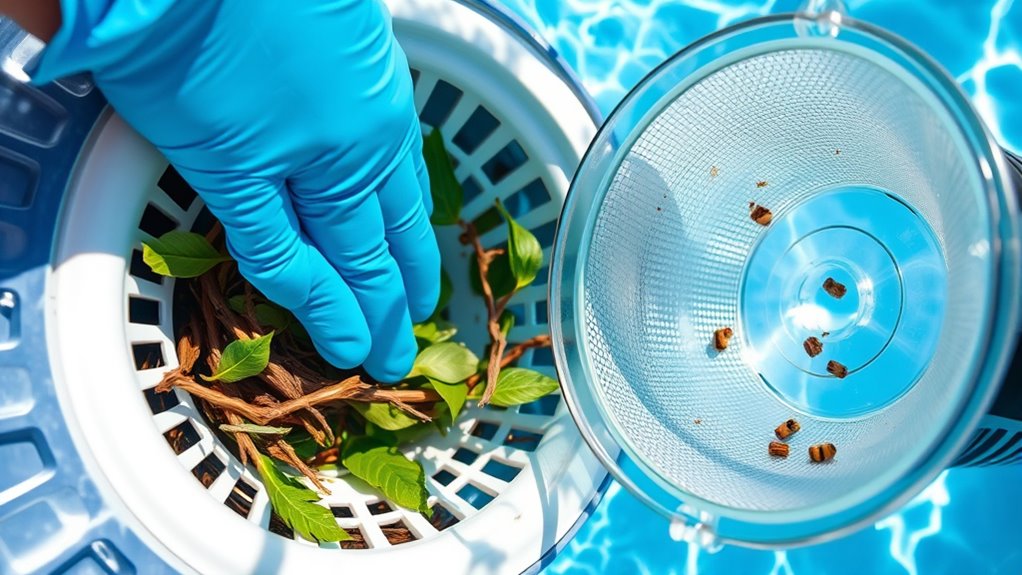
Obstructions in the skimmer and pump basket can considerably hinder your pool cleaner’s performance. Start by removing the skimmer basket and inspecting it for debris like leaves, dirt, or small objects. Clear out any blockages to guarantee smooth water flow. Next, check the pump basket; remove it and look for leaves, twigs, or buildup that could restrict water movement. If these baskets are clogged, your pool’s water flow drops, making it harder for the cleaner to operate effectively. Clean both baskets thoroughly with a hose if needed. Additionally, inspecting the pool filtration system can help identify other potential causes of flow restriction. Once clear, reassemble everything securely. Regularly examining the skimmer and pump basket helps prevent obstructions that can impair suction and keep your pool cleaner working efficiently. Additionally, understanding AI’s impact on privacy and regulation can inform how smart pool systems are monitored for data security.
Verifying the Pool’s Water Flow and Pressure Levels
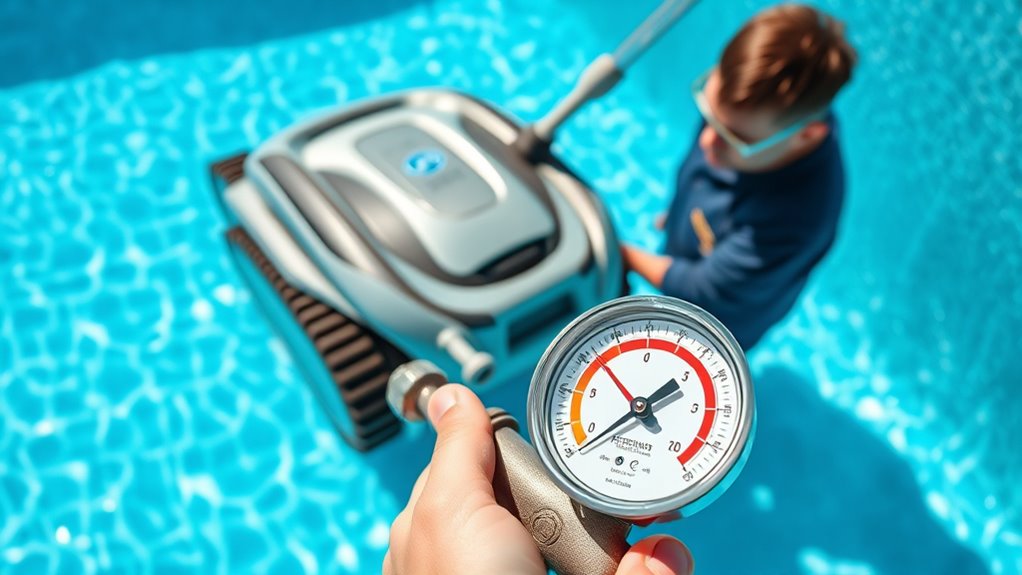
After clearing out any debris from the skimmer and pump baskets, it’s important to verify the pool’s water flow and pressure levels. This ensures your suction cleaner works efficiently. Check the pressure gauge on your filter; a normal range indicates proper water pressure. If the pressure is too low, your flow rate might be insufficient, reducing cleaning effectiveness. Conversely, high pressure can strain the system.
Verify pool pressure and flow after cleaning baskets to ensure efficient suction cleaner operation.
To troubleshoot, consider these steps:
- Confirm the skimmer and pump baskets are clean and unobstructed.
- Observe the pressure gauge for abnormal readings.
- Adjust the valve or pump settings if necessary to optimize water flow and pressure.
- Regularly inspect your pump components to maintain optimal performance.
- Remember that seasonal variations can also influence water flow and pressure, so adjustments may be needed accordingly.
- Monitoring these factors helps prevent system strain and extends the lifespan of your pool equipment.
- Ensuring proper filter maintenance can also help maintain consistent water flow and pressure.
- Understanding the water flow dynamics can assist in diagnosing issues more effectively.
Maintaining correct water pressure and flow rate prevents issues and keeps your cleaner operating smoothly.
Replacing or Repairing Damaged Parts and Seals
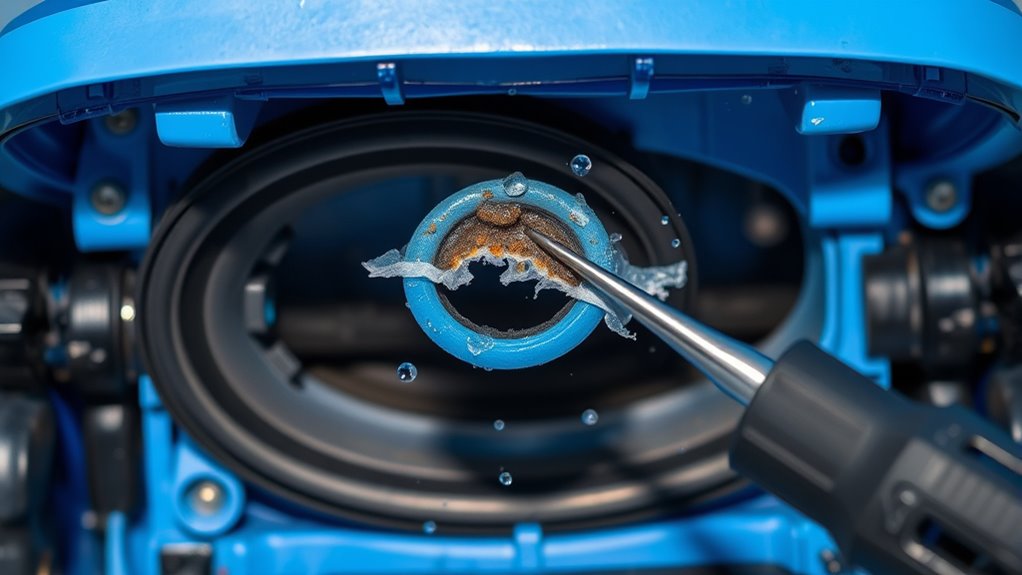
Damaged parts or seals can substantially reduce your suction pool cleaner’s performance, so inspecting them regularly is vital. If you notice a drop in suction or leaks, it’s time for seal replacement or fixing damaged parts. Start by turning off the cleaner and inspecting the seals for cracks, tears, or wear. Damaged parts, like hoses or brushes, should be replaced promptly to maintain peak suction. When replacing seals, ensure you select the correct size and type for your cleaner model. Proper installation is essential; a poorly fitted seal can cause leaks and reduce cleaning efficiency. Regularly check all components for damage, and replace worn or broken parts immediately to keep your pool cleaner working smoothly. Proper maintenance prevents bigger issues and extends your cleaner’s lifespan. Paying attention to seal integrity can help prevent costly repairs and ensure optimal performance. Additionally, following manufacturer recommendations for maintenance intervals can help identify potential problems early before they lead to significant damage. Checking the condition of hoses and brushes regularly can further enhance your cleaner’s lifespan and effectiveness. Incorporating routine inspections based on dog breed characteristics can also be helpful, especially if your cleaner operates in environments with pet hair or debris.
Maintaining Regular Cleaning and Preventative Checks
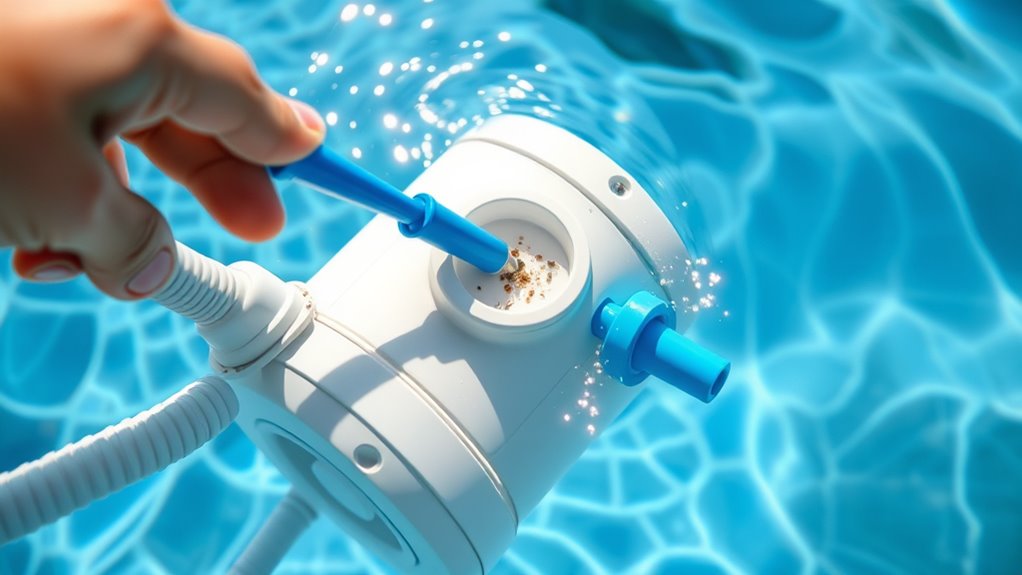
To keep your pool cleaner working smoothly, you should schedule regular cleanings and inspections. This helps catch obstructions or buildup before they cause problems. Staying proactive guarantees your cleaner operates efficiently and lasts longer.
Schedule Consistent Cleanings
Scheduling regular cleanings is essential to keep your suction pool cleaner operating at peak performance. By establishing a consistent cleaning routine, you reduce the risk of debris buildup and mechanical issues. To do this effectively, you should:
- Schedule Maintenance: Pick specific days weekly or biweekly to clean and inspect your cleaner, ensuring it functions smoothly.
- Choosing Cleaning Schedules: Adjust your cleaning frequency based on pool usage, weather, and debris levels to prevent overworking or neglect.
- Stick to It: Consistency is key—mark your calendar or set reminders so cleaning doesn’t slip through the cracks.
Regularly scheduling maintenance and choosing the right cleaning schedule helps catch potential problems early and prolongs your cleaner’s lifespan.
Inspect for Obstructions
Regularly inspecting your suction pool cleaner for obstructions helps guarantee it runs efficiently and prevents costly repairs. Check the intake and hoses for debris, leaves, or small objects that could block water flow. Obstructions can cause the cleaner to work harder, affecting pool chemistry by disrupting proper filtration and balance. Keep an eye on the skimmer and pump baskets, clearing out any buildup. When storing your cleaner, follow storage tips like rinsing it thoroughly and keeping it in a dry, shaded area to avoid mold and damage. Regular inspections ensure smooth operation and prolong the cleaner’s lifespan. By maintaining clear pathways and practicing good storage habits, you minimize the risk of obstructions and keep your pool cleaner functioning at its best.
Frequently Asked Questions
How Do I Recalibrate My Suction Pool Cleaner for Optimal Performance?
To recalibrate your suction pool cleaner for peak performance, start by checking the calibration tools included with your model. Adjust the water flow settings to guarantee the cleaner moves smoothly without losing suction. Make small adjustments and observe its movement, ensuring it covers the pool evenly. Regularly inspecting and fine-tuning these settings helps maintain proper calibration, giving you efficient cleaning and extending the life of your device.
What Are Signs of Internal Motor Failure in the Cleaner?
You’ll notice signs of internal motor failure if your cleaner shows unusual sound anomalies, like grinding or buzzing noises, during operation. Motor diagnostics can reveal decreased suction power or inconsistent movement, indicating the motor isn’t functioning properly. If your cleaner struggles to move or stops unexpectedly, it’s a clear sign to check the motor. Addressing these issues early helps prevent further damage and guarantees your pool stays clean.
Can Debris From Surrounding Trees Impact Cleaner Operation?
Like a silent thief in the night, tree debris can sneak into your pool, causing trouble. Yes, debris from surrounding trees and external obstructions can clog your cleaner’s pathways, reducing suction power and hindering operation. Regularly remove leaves, twigs, and other debris, especially after storms. Keeping the area clear guarantees your suction pool cleaner runs smoothly, saving you time and preventing potential damage caused by blockages.
How Does Water Chemistry Affect the Cleaner’S Efficiency?
Water chemistry affects your cleaner’s efficiency profoundly. If the water’s pH balance is off, it can cause the cleaner’s parts to corrode or stick, reducing cleaning power. Chemical imbalances, like excess chlorine or low alkalinity, can also damage the cleaner or hinder its movement. Regularly testing and adjusting your water’s pH and chemicals guarantees your suction pool cleaner operates smoothly, maintaining peak cleanliness and prolonging its lifespan.
Are There Specific Storage Tips to Extend the Cleaner’S Lifespan?
To extend your cleaner’s lifespan, follow proper storage tips and maintenance routines. After each use, rinse it thoroughly and guarantee it’s dry before storing. Keep it in a cool, shaded area away from direct sunlight and harsh weather. Regularly inspect and clean filters and brushes. Proper storage not only prevents damage but also keeps your cleaner in the best condition, making it last longer and work more efficiently season after season.
Conclusion
Think of your pool cleaner as a trusty ship sailing smoothly. When issues arise, it’s like steering through choppy waters. By checking the power, clearing clogs, and maintaining parts, you’re the captain steering it back on course. With patience and regular care, your cleaner will glide effortlessly, keeping your pool crystal clear. Remember, a well-maintained ship faces calmer seas—so stay vigilant, and your swimming paradise will always be within reach.
